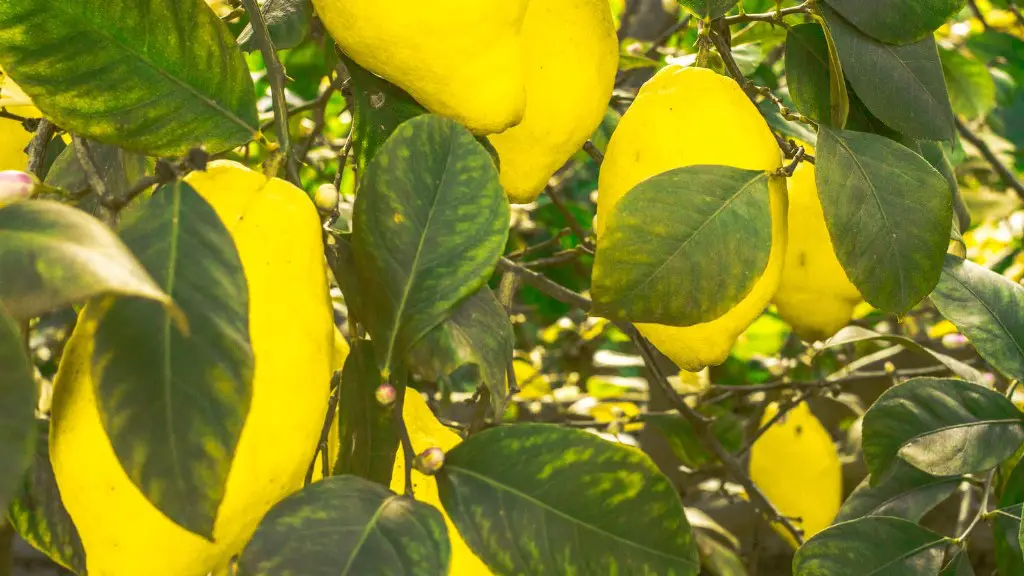Watering Frequency and Amount
Lemon trees in containers require frequent and adequate watering. A good rule of thumb is to water your tree when the top 2 inches of soil feel dry. If your lemon tree is kept in a warm, sunny location, you may need to water it more frequently — as often as twice per week. When it comes to amounts, it’s best to give enough water that the soil is completely saturated. An easy way to check for this is to water the tree until you see water coming out of the drainage holes.
Factors Affecting Water Requirements
Watering frequency and amount may be affected by various factors, including temperature and type of soil. In the summer, when temperatures are high and the soil is drier, you may need to water your tree more frequently. On the other hand, if temperatures stay mild and the soil is more moist, you won’t need to water your tree as often. Additionally, the type of soil plays a major role in the frequency of watering; sandy soils tend to dry out more quickly than other soil types.
Impact of Underwatering and Overwatering
Both underwatering and overwatering can be detrimental for lemon trees. If you don’t give your tree enough water, the leaves can become yellow and drop off. This can stunt the growth of the tree and reduce yields. Similarly, overwatering can also cause water stress, leading to yellowing leaves, root rot, and other diseases. To avoid either of these problems, monitor the soil often, and water your tree accordingly.
Ideas to Make Watering Easier
If watering your lemon tree often and correctly seems too tedious, there are a few things you can do to make it easier. A mulch layer can help to retain moisture in the soil, as well as protect the roots from the hot sun. Additionally, a soaker hose is a great option for giving deeper, longer waterings — simply hook it up to your garden hose and let it do the work for you.
Adding Nutrients and Fertilizers
In addition to watering your tree correctly, it’s important to give it the nutrients it needs for healthy growth. Lemon trees prefer a well-drained soil with plenty of organic matter. While organic fertilizers can give your tree the nutrients it needs, you may also want to think about using a fertilizer specifically designed for citrus trees. When fertilizing your tree, you should apply the fertilizer to a dry soil and then water it in.
Seasonal Checks and Maintenance
Finally, make sure to perform seasonal checks on your tree to make sure it’s getting enough water. In the summer, you should be watering your tree every 3-4 days, though this may vary depending on the soil and environment. In the winter months, check the soil every week or two. Doing so will ensure that your lemon tree is well-watered and thriving.
Types of Containers
When it comes to selecting an appropriate container for your lemon tree, it’s important to keep a few things in mind. While terra cotta pots are popular, they tend to dry out quickly and should generally be avoided. Instead, opt for a more breathable fabric pot, such as a felt or burlap bag. These allow for better air circulation, as well as easier watering and aeration.
Soil Mixes
In addition to selecting the proper container, make sure you’re using the best type of soil for your lemon tree. A good rule of thumb is to mix equal parts potting soil, compost, and perlite. This will create a well-drained soil that not only helps with aeration but also retains moisture for healthier growth. Additionally, when planting in a container, you can add 2-3 inches of gravel at the bottom of the pot for better drainage.
Drainage Holes and Placement
When it comes to containers, it’s important to make sure they have ample drainage holes. Otherwise, when you water your lemon tree, the soil will become too saturated, resulting in root rot and other problems. Additionally, make sure the container is placed in a sunny, sheltered spot — the brighter and warmer the location, the more water it’ll need.
Harvesting and Pruning
Harvesting and pruning are two important steps in maintaining your lemon tree. Depending on the variety you’re growing, your tree may need to be pruned every two to four months, in addition to harvesting any ripe lemons. In terms of harvesting, it’s best to wait until the lemons are fully ripe and yellow before picking them.
Winter Care
Finally, lemon trees need special care during the winter months. During this time, you should reduce watering frequency and make sure your tree is protected from frost and freezing temperatures. Additionally, it’s important to move your tree to a sheltered spot or indoors to ensure it stays warm and dry.
